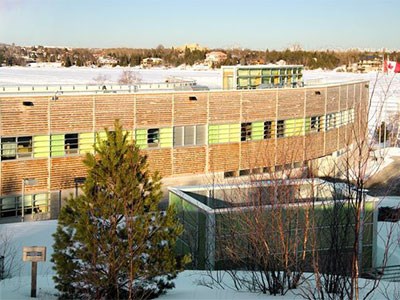J.L. Richards architect Jeff Laberge will tell you that designing a building that is structurally sound, aesthetically pleasing and environmentally sustainable comes with its own rewards. But when the industry around you recognizes that design for its architectural excellence, the rewards become that much sweeter.
In November, the firm was bestowed the Green Building Wood Design award from Wood WORKS! for its design of the Vale Living with Lakes Centre, a LEED platinum-certified pair of buildings situated on the shore of Ramsey Lake in Sudbury that opened in August 2011 to house the Co-operative Freshwater Ecology Unit.
Other accolades earned for the project include an Award of Excellence from Canadian Consulting Engineer magazine and a Holcim Award for Sustainable Construction.
“It’s nice to have your profession and the industry acknowledge that the project is successful and has lived up to expectation, because there was a lot of expectation on the job,” said Laberge, the project’s lead architect. “So that’s wonderful.”
Collaborating with Vancouver structural engineers Fast + Epp—the renowned firm that designed the wood roof in the skating oval for the 2010 Olympics—the decision to use wood throughout the design was made early on.
Despite its long history of forestry, Laberge said wood isn’t popular in the construction of Ontario’s buildings and is often viewed in a negative light. But as an advocate of the medium, Laberge was eager to incorporate it into the design.
“If we were going to build this building that was supposed to reflect the values of Northern Ontario, it’s just really, really obvious to us to say that it would be made out of wood and we’d maximize the amount of wood in the building,” he said.
The structure is comprised of glulam and post-and-beam construction, with wood-framed infill walls, and solid wood floor and roof decks. Eastern white cedar cladding from Manitoulin Island adorns the upper portion of the facility, and wood is used throughout the building.
Construction incorporated locally sourced wood, which was harvested, milled and processed in Chapleau, Thessalon and Temiskaming, a rarity when most northern timber is sent to southern Ontario or the U.S. for processing.
“I don’t think it’s a first for the world, but I think in Northern Ontario it proves you can do it,” Laberge said. “I’ve heard a lot of people say that you can’t, it’s hard to do, but I think we’ve shown that it can be done without too much difficulty.”
Designed to be 70 per cent more energy-efficient than a traditional building of comparable size, the centre is also being hailed for its sustainable construction. Elements include geo-exchange wells and heat pumps for heating and cooling; a green roof, which will have blueberries planted on it this spring, to filter stormwater runoff and repurpose it as grey water; and a series of sensors and controls throughout the building to monitor temperature and humidity.
J.L. Richards has submitted its application for LEED platinum status and expected to hear back in the early new year.
Eighteen months after the Co-operative Freshwater Ecology Unit moved into its new digs, the building has passed several benchmarks and is working as designed, Laberge said. Flexible office space has been adjusted to incorporate two additional offices, after the original offices were filled up more quickly than anticipated, Laberge noted. Lab space was equally adaptable.
“Watching it over the year and a half, it’s responded really well to the needs and has been flexible,” he said. “There have been some spaces that have been surprisingly well used; some things that I didn’t think would get as much use as they have been.”
Laberge said he’s been overwhelmed by the community response to the building. Curiosity about how the building works remains high, its popularity reflected in the numbers of people taking tours of the facility.
“For me, personally, that’s a success story in itself,” Laberge said. “It’s rare to have a building anywhere, let alone in Sudbury, that people are interested in and they want to come and see, so that’s been very good.”




